http://bukitbrown.com/main/?p=8731
Chronology of the Japanese Invasion in Singapore (1942)
12
This chronology of the Japanese invasion was compiled by James Tann, a heritage blogger, in the lead up to the 72nd anniversary of the fall of Singapore on 15 February, 1942.
Feb 8, 1942.
The Japanese Army invasion of Singapore Island begins with the crossing at Lim Chu Kang.

Photo credit Australian War Memorial
February 9, 1942.
Having landed the night before along the Lim Chu Kang coast, by the afternoon of 9th Feb, Tengah Airfield was in the hands of the invading Japanese Imperial Army.
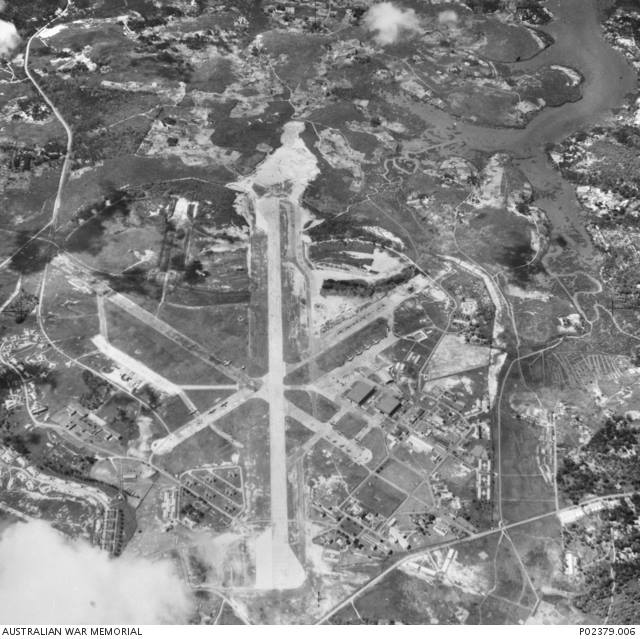
Also on 9 Feb, the Japanese Army opened a 2nd battle front by landing the Imperial Guards Division at Kranji and the Causeway. This Division was to move east heading towards the Sembawang & Thomson regions.
The Jurong-Kranji Line – 9th February, 1942.
The Allied forces formed a futile blockade called the ‘Jurong Line’ stretching east of Tengah Airfield, through Bulim to the Jurong River (where Chinese Garden is today) to try and contain the Japanese forces within the western sector of Singapore.
By evening of 9th Feb 1942, the Jurong Line had collapsed completely due to miscommunication. The main Australian 22nd Brigade retreated, resulting in a domino effect leading other units to retreat as well.
Luckily for them, the Japanese forces did not press their advantage as they had to wait for reinforcements and logistic supplies to follow up across the Straits to continue the invasion.

Map of the battle lines by James Tann
You can also read how a jungle dirt track saved the lives of 400 soldiers by James Tann here
10th Feb 1942.
The capture of Bukit Panjang and the massacre at Bukit Batok.
With the overnight collapse of the ‘Jurong Line’ blockade, the Japanese 5th Division easily manoeuvred down Choa Chu Kang Road and overpowered the defences by the Argylls & Sutherland Highlanders and the Hyderabad Regiment at Keat Hong. Pushing them back all the way to Bukit Panjang Village. It was the first encounter with Japanese tanks in Singapore by the British.
By the early afternoon, Bukit Panjang Village had fallen to the Japanese. Some British units managed to escape through the farmlands of Cheng Hwa and eventually followed the water pipeline down to British lines near the Turf Club region.
Intending to re-establish the ‘Jurong Line’, the British High Command despatched 2 battalions from Ulu Pandan to Bukit Batok (West Bukit Timah).
X Battalion made it way to 9ms Jurong Road (opp today’s Bukit View Sec Sch), while Merret Force lost its way and camped at Hill 85 (Toh Guan Road today).
The Japanese 18th Div coming down Jurong Road encountered both X Battalion and Merret Force during the night. X Bn, caught totally off guard, was annihilated and lost over 280 men, while Merret Force had half its force killed in the ambush.
The Japanese Commander, Gen Yamashita, had ordered both his 5th and 18th Division to take Bukit Timah Village and Bukit Timah Hill by the 11th Feb. Thus, both units were in a frenzied rush to capture the strategic high point.
By midnight of 10th Feb, Bukit Timah Village was ablaze and effectively conquered by the invasion force.
Photo credits: Australian War Memorial
1. Japanese soldiers at Bukit Timah Hill
2. Japanese Type 95 HaGo Light Tanks in Bukit Timah Village
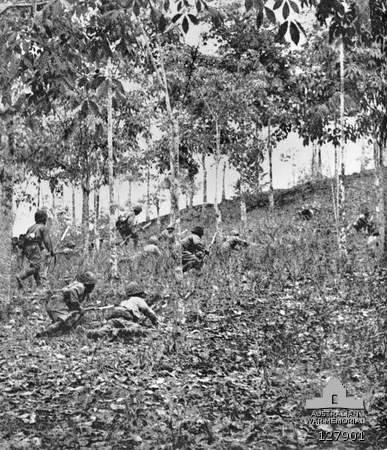
10 Feb Japanese soldiers at Bukit Timah hill (photo Australian War Memorial)

10 Feb Japanese Type 95 HaGo Light Tanks in Bukit Timah Village (photo Australian War Memorial)
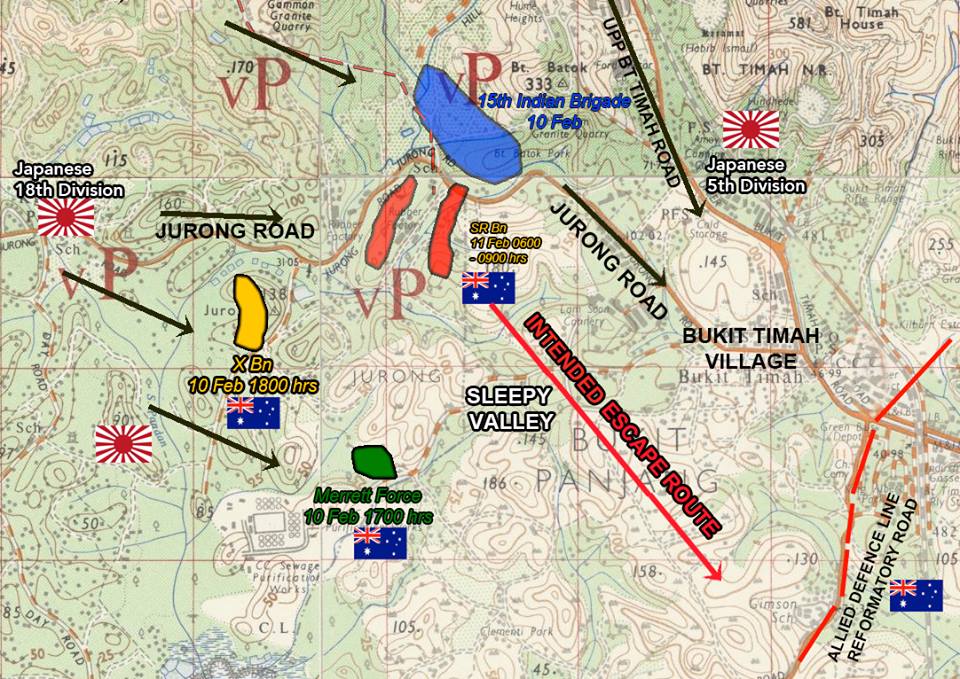
Map of battle lines on 10 Feb by James Tann
11th February 1942.
The Fall of Bukit Timah Hill and the Tragedy at Sleepy Valley.
By the time Gen.Yamashita’s army crossed into Singapore, he was critically short of supplies, fuel, ammunition and even food for his troops. His strategy was thus to conduct a tropical blitzkrieg – ‘hit them fast hit them hard’ – to capture Bukit Timah. It being the high point for observation also held the British ammunition, food and fuel depots which he coveted.
To raise morale of his troops, he set Feb 11 as the day to capture Bukit Timah Hill. The significance of Feb 11 was that it was the Japanese Kigensetsu, the day they celebrate the ascension of the 1st Emperor and the founding of the Japanese Empire. The task was assigned to competing 5th and 18th Divisions with untold glory going to the unit achieving the objective first.
By midnight of 10th Feb, both units had already reached Bukit Timah Village and the resultant battle against the British defenders set the entire region ablaze. The British retreated and held their line at Reformatory Road (Clementi Road)
By early morning of the 11th, the Japanese had secured Bukit Timah Hill.
Meanwhile back at Bukit Batok…
By the morning of 11 Feb, the senior commander of 15th Brigade, Brigadier Coates, who was to lead the re-taking of the Jurong Line, knew that the Japanese had surrounded his position. He cancelled the order and proceeded to retreat, together with the Special Reserve Battalion, back to allied lines at Ulu Pandan.
Forming 3 columns consisting of 1500 men from the British, Indian and Australian units, they proceeded from Bukit Batok to cross an area called Sleepy Valley.
Unknown to them, the Japanese 18th Division was already waiting to spring their trap on the British soldiers.
What happened next is a seldom mentioned debacle which actually had the highest number of casualties of any skirmish within Singapore during the war. The firefight that took place at Sleepy Valley took the lives of 1100 allied soldiers out of the 1500 who entered that valley of death.
Throughout the day, the British sent in reinforcements to try and re-take Bukit Timah. However, both Tomforce and Massey Force could do little to dislodge the Japanese.
When Bukit Timah Hill fell, Gen Percival moved his HQ from Sime Road to Fort Canning. The fear of the approaching Japanese Army also led them to destroy the infamous 15” Guns at Buona Vista Camp at Ulu Pandan that morning. It was a sign that things had come to bear…
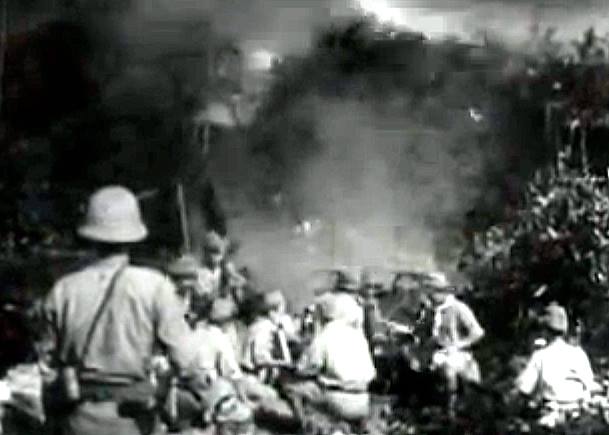
Japanese soldiers at Bukit Timah Village (photo Australian War Memorial)

General Tomoyuki Yamashita (photo Australian War Memorial)

Johore Battery 15″ Gun. Changi (Australian War Memorial)
12th Feb 1942.
Yamashita’s Ultimatum.
Tomforce’s attempt to re-take Bukit Timah and Bukti Panjang ended in futility. Unknown to them, they were up against the battle hardened Japanese 56th and 114th Regiments of the 18th IJA Division, Yamashita’s crack troops, who had fought all the way from China.
By the morning of 12th Feb, the British lines were being pushed backed.
Tomforce fell back from Reformatory (Clementi) Road to Racecourse when the Japanese overran the supply depots at Rifle Range. By the end of the day they would retreat all the way back to Adam and Farrer Road.
By then, Gen Percival had redrawn the defence line.
Massey Force would protect the waterworks from Thomson Village to the east of the MacRitchie golf links, where the former HQ at Sime Road was.
Gen Heath’s British units would fall back from Nee Soon, having abandoned the Naval Base, and form the line from Braddell to Kallang.
In the west, the Australians fell back from Reformatory Road to Holland Road (Old Holland Road), while the 44th Indian Brigade formed the line from Ulu Pandan to Pasir Panjang. Sporadic fighting occurred throughout the day along the line.
Elated with the capture of Bukit Timah, Gen.Yamashita was still faced with logistical problems including a critical shortage of ammunition. He knew he wouldn’t be able to last out in a war of attrition and thus resorted to his plan to bluff the British into surrendering, by dropping ultimatum notes into the British lines.
“To the High Command of the British Army, Singapore”
I, the High Command of the Nippon Army have the honour of presenting this note to Your Excellency advising you to surrender the whole force in Malaya.
My sincere respect is due to your army…bravely defending Singapore which now stands isolated and unaided…..futile resistance would only serve to inflict direct harm and injuries to thousands of non-combatants….Give up this meaningless and desperate resistance…If Your Excellency should neglect my advice, I shall be obliged, though reluctantly from humanitarian considerations to order my army to make annihilating attacks..”
(signed) Tomoyuki Yamashita”
Getting no response to his ultimatum message, Yamashita sent his units on probing incursions along the line.
These took place mainly at Sime Road and Pasir Panjang near Normanton.
He had no intention to enter the city as he knew he did not have the resources to fight a street to street battle.

Major Bert Saggers was CO of the Special Reserve Bn that was ambushed at Sleepy Valley. He survived and made his way to Ulu Pandan where he found only 80 of his 420 men alive but all his officers killed. (photo Ian Saggers, Perth Australia )
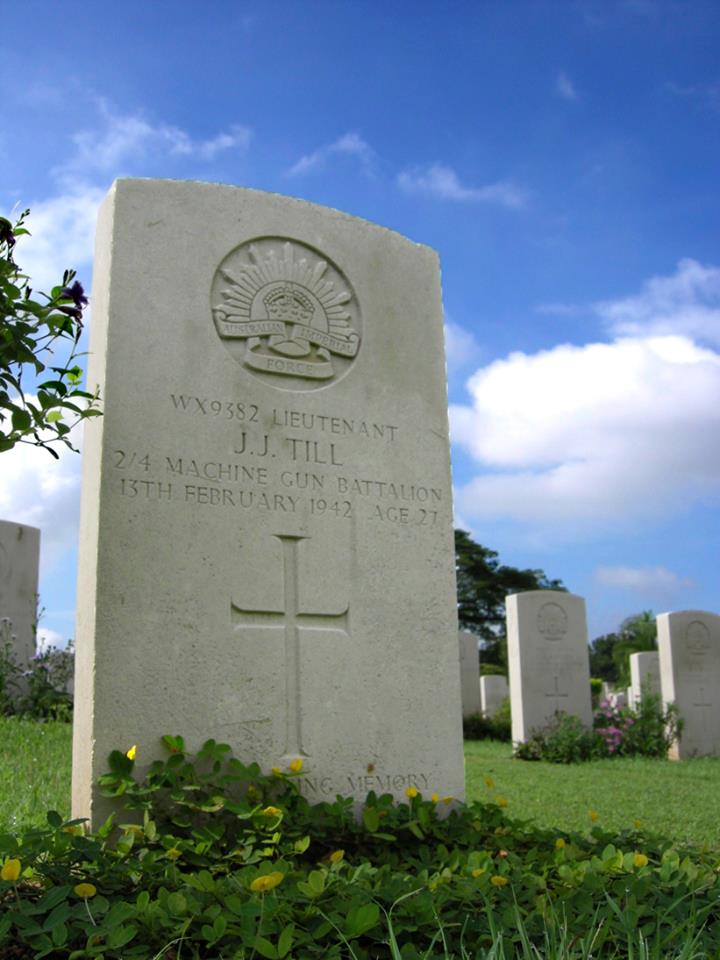
Lt Jimmy Till was an officer in Bert Sagger’s unit. He was buried near the spot where he was killed. This was near where today’s Ngee Ann Polytechnic Alumni Clubhouse stands. Picture is his grave now at Kranji War Memorial. (photo James Tann)
13th Feb 1942.
The noose tightens around Singapore City.
With the core of Singapore Island firmly in the hands of the Japanese Army, Gen.Yamashita moved his HQ from Tengah to the Ford Motors factory at Bukit Timah.
Strangely, the previous day ended somewhat with a lull in the fighting.
This allowed Gen Percival to continue finalising his last line of defence.
From Kallang Airfield to Paya Lebar, Paya Lebar to Braddell, Thomson Village to Adam Park, Adam Road to Farrer Road to Tanglin Halt, from Buona Vista across Pasir Panjang ending at Pasir Panjang Village.
The last unit to pull out , the 53rd Brigade, left Ang Mo Kio area around noon and the traffic along Thomson Road was so choked that Japanese planes had an easy time strafing the columns along the route.
Gen.Yamashita had actually feared that Gen.Percival would dig in and fight to the last.
In order to continue his feint, despite running low on ammunition and men, he launched attacks to give the British the appearance of Japanese strength.
He ordered the crack 18th Division to take Alexandra Barracks and the 5th Div & the Imperial Guards to attack the Waterworks at MacRitchie and the pumping station at Woodleigh.
Alexandra Barracks was the main British Army Ordnance Depot, where most of their equipment, stores and fuel storage, as well as the main Alexandra Military Hospital, were located
The attack on Alexandra Barracks began from Pasir Panjang (Kent Ridge) after 2 hours of heavy shelling at noon.
Waves of Japanese soldiers fought determined defenders from the 1st Malaya Brigade and the 44th Indian Brigade. Fighting was vicious and often hand to hand. The Malay Regiments were slowly overpowered with the Japanese winning height after height. The Gap, Pasir Panjang Hill III, Opium Hill, Buona Vista Hill, would fall one after the other but fighting would continue till the following day.
Over at MacRitchie, the Japanese 5th Division fought the 55th Brigade (1 Cambridgeshire & 4 Suffolk Regiments) to gain control of the reservoir. An all night tough fight including tanks forced the British Regiments all the way back to Mount Pleasant Road across Bukit Brown cemetery. The Suffolks lost over 250 men defending their ground.
The Japanese Army was now within 5 kilometres of the City on 2 fronts.
All this while, civilians casualties were mounting in the collateral damage from the Japanese shelling.
The City now had up to 1 million evacuees, most in dire straits without shelter, food nor water.
An Officer was to record travelling down Orchard Road:
“Buildings on both side went up in smoke…civilians appeared through clouds of debris; some got on the road, others stumbled and dropped in their tracks, others shrieked as they ran for safety. We pulled up near a building which had collapsed, it looked like a slaughter house; blood splashed, chunks of human being littered the place. Everywhere bits of steaming flesh, smouldering rags, clouds of dust and the groans of those who still survived.”
At the Battlebox, the new HQ at Fort Canning, Gen.Percival and his senior commanders were contemplating the latest orders from Gen.Wavell as well as an order from Churchill.

13 Feb: Smoke arising from bombardment of Singapore City Feb 1942 (photo Australian War Memorial
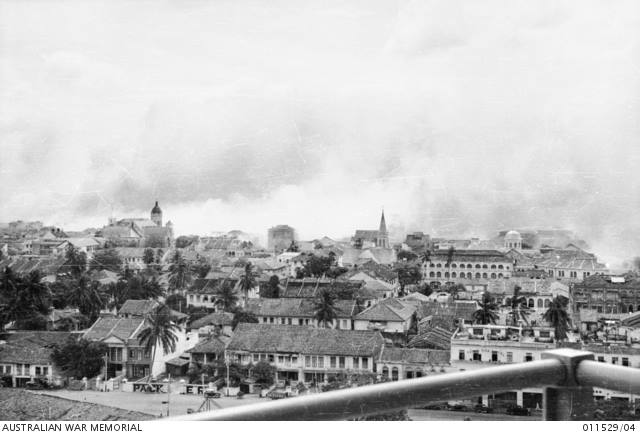
14th Feb 1942.
Prelude to Capitulation
Throughout the night of 13/14th Feb, sporadic skirmishes occurred both at Pasir Panjang and Adam Road.
At daylight 8.30am at Pasir Panjang Ridge , the Japanese charged up for a final assault on Hill 226 and Opium Hill facing heavy resistance from the 1st Malay Regiment. Bitter hand to hand combat lasted till 1.00pm in the afternoon when the Japanese gained control of the hills and in the process annihilating the Malay Regiment.
As the loss of the strategic ridge gave way, the Japanese advanced along Ayer Rajah in pursuit of Indian troops towards the British Military Hospital. It was then that the tragic incident occurred at the BMH with the senseless slaughter of wounded patients and medical staff.
There was also little relief along Adam Road. The Japanese, with Col Shimada’s Tank Regiment, pressured the line with a bulge through Bukit Brown, towards Caldecott Hill and Adam Park. Bitter fighting occurred around Hill 95 and Water Tower Hill (today’s Adam Park/Arcadia).
The Imperial Guards Division harried the eastern battle line at Paya Lebar and were near to capturing the Woodleigh pump station by mid day.
At British HQ in the BattleBox at Fort Canning, Gen.Percival conferred with his field commanders.
Brigadier Simson advised that the water situation was extremely grave with the threat of epidemic.
Gen Heath, commander of British Forces, and Gen Bennett, commander of Australian Forces, urged Gen Percival to surrender. Percival refused to yield, having direct orders from Churchill via Gen.Wavell, the Commander in Chief based at Java, not to surrender and to fight to the last man.
However, Gen.Percival informed Gen.Wavell that the enemy was close to the City and that his troops were no longer in a position to counter attack much longer.
Gen. Wavell sought permission from PM Churchill to allow Gen.Percival to consider the option of surrendering.
Churchill replied to Gen. Wavell:
“You are, of course, sole judge of the moment when no further result can be gained at Singapore., and should instruct Percival accordingly, C.I.G.S. concurs”
With that, the final key was inserted into play for Singapore. (But the permission for Percival to consider surrendering did not go out to Percival until the next morning of the 15th.)
*CIGS = Chief of Imperial General Staff
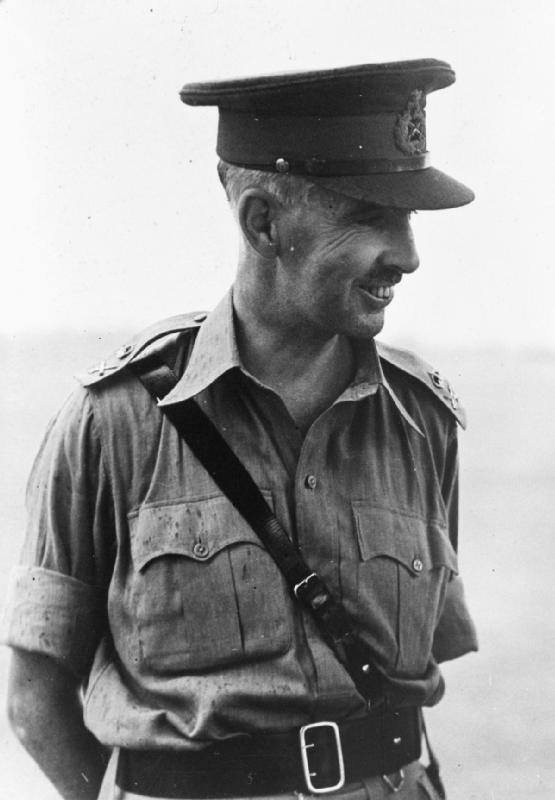
Lieutenant-General A E Percival, General Officer Commanding Malaya at the time of the Japanese attack.(photo Imperial War Museum London)
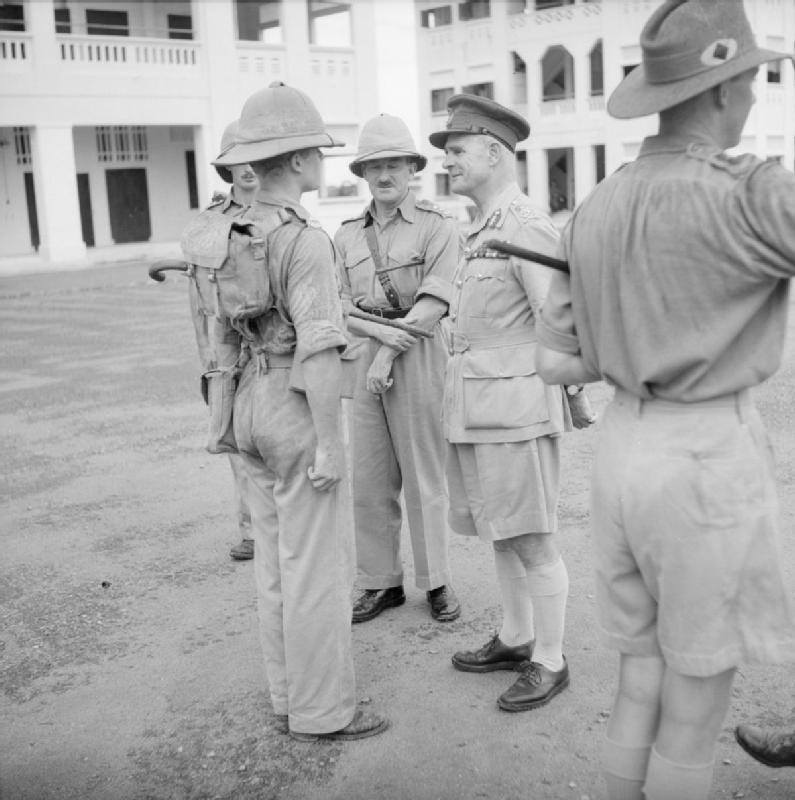
General Sir Archibald Wavell, C-in-C Far East, and Major General F K Simmons, GOC Singapore Fortress, inspecting soldiers of the 2nd Gordon Highlanders, Singapore, 3 November 1941. (photo Imperial War Museum London)
15th Feb 1942.
Chinese New Year – The Year of the Horse
There was absolutely no joy in celebrating Chinese New Year in 1942. The country was in shambles.
The foreboding fear of the encroaching Japanese military, preceeded by tales and rumours of their atrocities in China all portent the unknown that lay ahead.The British masters and their families had all bugged out. What did this mean for the locals now?
A Japanese flag could he seen flying from the top of the Cathay Building! Was this the end?
For the locals, especially for the Chinese, it was going to be the start of three and a half horrifying years.
Morning of 15th Feb saw the opposing forces holding most of their ground, with infiltration mainly by the Japanese within the eastern sector reaching Kallang Airfield. In the west, Japanese troops reached Mount Faber.
Gen. Percival convened his most senior officers at the Battlebox at 9.30am for the latest status reports.
Brigadier Simson reported that water supply could not be maintained for more than a day due to breakages everywhere which could not be repaired. Water was still flowing despite the pumps and reservoir being in enemy’s hands!
The only fuel left were what remained in each vehicle and at a small pump at the Polo Club.
Reserved military rations could last for only a few more days.
With unanimous concurrence of all present, the decision to cease hostilities and to capitulate was made.
A deputation comprising Brigadier Newbigging, HQ Chief Admin Officer, the Colonial Secretary Mr Fraser and Major CH Wild as interpreter, left Fort Canning for the enemy lines at Bukit Timah Road.
At the junction of Farrer Road, they proceeded on foot with Union Flag and a white flag across the defence line for 600 yards where they were met by the Japanese soldiers. They were later met by Col Sugita who refused their ‘invitation’ to the City for negotiations. Instead, Col Sugita demanded that Gen.Percival was to personally surrender to Gen.Yamashita.
To acknowledge this condition, the British were to fly a Japanese Flag from the top of the Cathay Building.
At 5.15pm, the British surrender party drove up to the Bukit Timah Ford Motors factory.
The delegation was made up of Lt-Gen AE Percival, Brigadier Newbigging, Brigadier Torrance, Gen Staff Officer Malaya Command, and Major Wild, the interpreter from III Corps.
Though Gen.Percival tried to negotiate for some terms for his men, Gen Yamashita thought that he was playing for time and pressed Percival for an unconditional surrender, telling him that a major attack on the City was scheduled for 10.30pm that night and any delay, he might not be able to call off the operation in time.
“The time for the night attack is drawing near! Is the British Army going to surrender or not?”
Banging the table he shouted in English “Answer YES or NO.”
At 6.10 pm. Gen.Percival signed the surrender document, handing Singapore over to the Japanese Empire.

15 February, 1942 Singapore Falls (photo Imperial War Museum London)
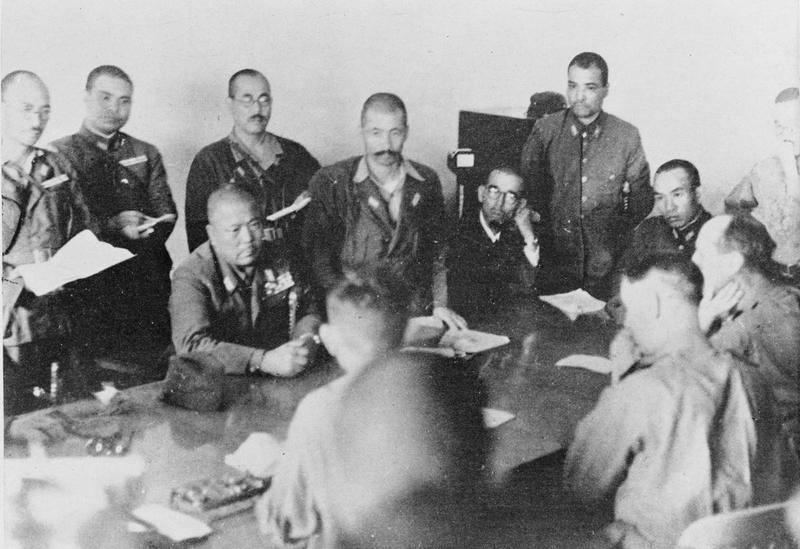
15 February, 1942 The Surrender (photo Imperial War Museum London)
************************
Read about the Battle at Bukit Brown on 14 February, 1942, a day before the surrender to the Japanese, here
And the latest on missing soldiers here

Tagged:
http://eresources.nlb.gov.sg/history/events/b29e03c8-9f7a-4ba7-a807-b570ca4cea16
Singapore Falls to The Japanese 15.Feb 1942
Back to Previous Page


Singapore falls to the
Japanese 15th Feb 1942
1
On 15 February 1942, which was the first day of the Lunar New Year, Lieutenant General Arthur E. Percival, who was then the General Officer Commanding (Malaya), signed the surrender documents before Lieutenant General Tomoyuki Yamashita, Commander of the Japanese 25th Army that invaded Malaya on 8 December 1941. The meeting took place at the Ford Motor Factory, which had been made Yamashita’s headquarters, located in Upper Bukit Timah Road.[1]
Upon convening at the Ford Motor Factory on the evening of 15 February with three other military officers, Percival tried to negotiate with Yamashita on some of the conditions for the surrender of Singapore.[2] Percival wished to delay the ceasefire so as to ensure that all of his men received their orders on time. He also wished to keep 1,000 men armed as he was afraid that the Japanese would retaliate against the local population.[3]
Yamashita, who later described his attack on Singapore as “a bluff that worked”,[4] feared the British were trying to buy time for more reinforcements to arrive.[5] He was particularly worried that the British might discover the truth about the actual situation of his troops, in particular their numerical inferiority compared to the British and their shortage of supplies and ammunition.[6] Hence, Yamashita threatened to carry on with the attack planned for that night if Percival did not acquiesce to his demands. Faced with no other choice, Percival signed the surrender documents, thereby sealing the fate of Singapore and subjecting the island to three-and-a-half years of Japanese occupation.[7]
References
1. National Library Board. (2001). The British surrender team of 1942 written by Cornelius-Takahama, Vernon. Retrieved December 19, 2013, from Singapore Infopedia; National Library Board. (2013, July 19). Battle of Singapore written by Ho, Stephanie. Retrieved December 19, 2013, from Singapore Infopedia.
2. Tsuji, M. (1988). Singapore 1941–1942: The Japanese version of the Malayan campaign of World War II (pp. 266–267). (M. E. Lake, Trans.). Singapore: Oxford University Press. Call no.: RSING 940. 5425 TSU.
3. Kinvig, C. (1996). Scapegoat: General Percival of Singapore (pp. 218–219). London: Brassey's UK. Call no.: RSING 940.5425 KIN.
4. Potter, J. D. (1963). A soldier must hang: The biography of an oriental general (p. 81). London: Muller. Call no.: RCLOS 940.541352 POT.
5. Potter, 1963, p. 91.
6. Potter, 1963, p. 92.
7. Kinvig, 1996, p. 219; Allen, L. (1993). Singapore, 1941–1942 (pp. 180–183). London: Frank Cass. Call no.: RSING 940.5425 ALL.
The information in this article is valid as at 2014 and correct as far as we are able to ascertain from our sources. It is not intended to be an exhaustive or complete history of the subject. Please contact the Library for further reading materials on the topic.
Chronology of the Japanese Invasion in Singapore (1942)
12
This chronology of the Japanese invasion was compiled by James Tann, a heritage blogger, in the lead up to the 72nd anniversary of the fall of Singapore on 15 February, 1942.
Feb 8, 1942.
The Japanese Army invasion of Singapore Island begins with the crossing at Lim Chu Kang.

Photo credit Australian War Memorial
February 9, 1942.
Having landed the night before along the Lim Chu Kang coast, by the afternoon of 9th Feb, Tengah Airfield was in the hands of the invading Japanese Imperial Army.

Also on 9 Feb, the Japanese Army opened a 2nd battle front by landing the Imperial Guards Division at Kranji and the Causeway. This Division was to move east heading towards the Sembawang & Thomson regions.
The Jurong-Kranji Line – 9th February, 1942.
The Allied forces formed a futile blockade called the ‘Jurong Line’ stretching east of Tengah Airfield, through Bulim to the Jurong River (where Chinese Garden is today) to try and contain the Japanese forces within the western sector of Singapore.
By evening of 9th Feb 1942, the Jurong Line had collapsed completely due to miscommunication. The main Australian 22nd Brigade retreated, resulting in a domino effect leading other units to retreat as well.
Luckily for them, the Japanese forces did not press their advantage as they had to wait for reinforcements and logistic supplies to follow up across the Straits to continue the invasion.

Map of the battle lines by James Tann
You can also read how a jungle dirt track saved the lives of 400 soldiers by James Tann here
10th Feb 1942.
The capture of Bukit Panjang and the massacre at Bukit Batok.
With the overnight collapse of the ‘Jurong Line’ blockade, the Japanese 5th Division easily manoeuvred down Choa Chu Kang Road and overpowered the defences by the Argylls & Sutherland Highlanders and the Hyderabad Regiment at Keat Hong. Pushing them back all the way to Bukit Panjang Village. It was the first encounter with Japanese tanks in Singapore by the British.
By the early afternoon, Bukit Panjang Village had fallen to the Japanese. Some British units managed to escape through the farmlands of Cheng Hwa and eventually followed the water pipeline down to British lines near the Turf Club region.
Intending to re-establish the ‘Jurong Line’, the British High Command despatched 2 battalions from Ulu Pandan to Bukit Batok (West Bukit Timah).
X Battalion made it way to 9ms Jurong Road (opp today’s Bukit View Sec Sch), while Merret Force lost its way and camped at Hill 85 (Toh Guan Road today).
The Japanese 18th Div coming down Jurong Road encountered both X Battalion and Merret Force during the night. X Bn, caught totally off guard, was annihilated and lost over 280 men, while Merret Force had half its force killed in the ambush.
The Japanese Commander, Gen Yamashita, had ordered both his 5th and 18th Division to take Bukit Timah Village and Bukit Timah Hill by the 11th Feb. Thus, both units were in a frenzied rush to capture the strategic high point.
By midnight of 10th Feb, Bukit Timah Village was ablaze and effectively conquered by the invasion force.
Photo credits: Australian War Memorial
1. Japanese soldiers at Bukit Timah Hill
2. Japanese Type 95 HaGo Light Tanks in Bukit Timah Village

10 Feb Japanese soldiers at Bukit Timah hill (photo Australian War Memorial)

10 Feb Japanese Type 95 HaGo Light Tanks in Bukit Timah Village (photo Australian War Memorial)

Map of battle lines on 10 Feb by James Tann
11th February 1942.
The Fall of Bukit Timah Hill and the Tragedy at Sleepy Valley.
By the time Gen.Yamashita’s army crossed into Singapore, he was critically short of supplies, fuel, ammunition and even food for his troops. His strategy was thus to conduct a tropical blitzkrieg – ‘hit them fast hit them hard’ – to capture Bukit Timah. It being the high point for observation also held the British ammunition, food and fuel depots which he coveted.
To raise morale of his troops, he set Feb 11 as the day to capture Bukit Timah Hill. The significance of Feb 11 was that it was the Japanese Kigensetsu, the day they celebrate the ascension of the 1st Emperor and the founding of the Japanese Empire. The task was assigned to competing 5th and 18th Divisions with untold glory going to the unit achieving the objective first.
By midnight of 10th Feb, both units had already reached Bukit Timah Village and the resultant battle against the British defenders set the entire region ablaze. The British retreated and held their line at Reformatory Road (Clementi Road)
By early morning of the 11th, the Japanese had secured Bukit Timah Hill.
Meanwhile back at Bukit Batok…
By the morning of 11 Feb, the senior commander of 15th Brigade, Brigadier Coates, who was to lead the re-taking of the Jurong Line, knew that the Japanese had surrounded his position. He cancelled the order and proceeded to retreat, together with the Special Reserve Battalion, back to allied lines at Ulu Pandan.
Forming 3 columns consisting of 1500 men from the British, Indian and Australian units, they proceeded from Bukit Batok to cross an area called Sleepy Valley.
Unknown to them, the Japanese 18th Division was already waiting to spring their trap on the British soldiers.
What happened next is a seldom mentioned debacle which actually had the highest number of casualties of any skirmish within Singapore during the war. The firefight that took place at Sleepy Valley took the lives of 1100 allied soldiers out of the 1500 who entered that valley of death.
Throughout the day, the British sent in reinforcements to try and re-take Bukit Timah. However, both Tomforce and Massey Force could do little to dislodge the Japanese.
When Bukit Timah Hill fell, Gen Percival moved his HQ from Sime Road to Fort Canning. The fear of the approaching Japanese Army also led them to destroy the infamous 15” Guns at Buona Vista Camp at Ulu Pandan that morning. It was a sign that things had come to bear…

Japanese soldiers at Bukit Timah Village (photo Australian War Memorial)

General Tomoyuki Yamashita (photo Australian War Memorial)

Johore Battery 15″ Gun. Changi (Australian War Memorial)
12th Feb 1942.
Yamashita’s Ultimatum.
Tomforce’s attempt to re-take Bukit Timah and Bukti Panjang ended in futility. Unknown to them, they were up against the battle hardened Japanese 56th and 114th Regiments of the 18th IJA Division, Yamashita’s crack troops, who had fought all the way from China.
By the morning of 12th Feb, the British lines were being pushed backed.
Tomforce fell back from Reformatory (Clementi) Road to Racecourse when the Japanese overran the supply depots at Rifle Range. By the end of the day they would retreat all the way back to Adam and Farrer Road.
By then, Gen Percival had redrawn the defence line.
Massey Force would protect the waterworks from Thomson Village to the east of the MacRitchie golf links, where the former HQ at Sime Road was.
Gen Heath’s British units would fall back from Nee Soon, having abandoned the Naval Base, and form the line from Braddell to Kallang.
In the west, the Australians fell back from Reformatory Road to Holland Road (Old Holland Road), while the 44th Indian Brigade formed the line from Ulu Pandan to Pasir Panjang. Sporadic fighting occurred throughout the day along the line.
Elated with the capture of Bukit Timah, Gen.Yamashita was still faced with logistical problems including a critical shortage of ammunition. He knew he wouldn’t be able to last out in a war of attrition and thus resorted to his plan to bluff the British into surrendering, by dropping ultimatum notes into the British lines.
“To the High Command of the British Army, Singapore”
I, the High Command of the Nippon Army have the honour of presenting this note to Your Excellency advising you to surrender the whole force in Malaya.
My sincere respect is due to your army…bravely defending Singapore which now stands isolated and unaided…..futile resistance would only serve to inflict direct harm and injuries to thousands of non-combatants….Give up this meaningless and desperate resistance…If Your Excellency should neglect my advice, I shall be obliged, though reluctantly from humanitarian considerations to order my army to make annihilating attacks..”
(signed) Tomoyuki Yamashita”
Getting no response to his ultimatum message, Yamashita sent his units on probing incursions along the line.
These took place mainly at Sime Road and Pasir Panjang near Normanton.
He had no intention to enter the city as he knew he did not have the resources to fight a street to street battle.

Major Bert Saggers was CO of the Special Reserve Bn that was ambushed at Sleepy Valley. He survived and made his way to Ulu Pandan where he found only 80 of his 420 men alive but all his officers killed. (photo Ian Saggers, Perth Australia )

Lt Jimmy Till was an officer in Bert Sagger’s unit. He was buried near the spot where he was killed. This was near where today’s Ngee Ann Polytechnic Alumni Clubhouse stands. Picture is his grave now at Kranji War Memorial. (photo James Tann)
13th Feb 1942.
The noose tightens around Singapore City.
With the core of Singapore Island firmly in the hands of the Japanese Army, Gen.Yamashita moved his HQ from Tengah to the Ford Motors factory at Bukit Timah.
Strangely, the previous day ended somewhat with a lull in the fighting.
This allowed Gen Percival to continue finalising his last line of defence.
From Kallang Airfield to Paya Lebar, Paya Lebar to Braddell, Thomson Village to Adam Park, Adam Road to Farrer Road to Tanglin Halt, from Buona Vista across Pasir Panjang ending at Pasir Panjang Village.
The last unit to pull out , the 53rd Brigade, left Ang Mo Kio area around noon and the traffic along Thomson Road was so choked that Japanese planes had an easy time strafing the columns along the route.
Gen.Yamashita had actually feared that Gen.Percival would dig in and fight to the last.
In order to continue his feint, despite running low on ammunition and men, he launched attacks to give the British the appearance of Japanese strength.
He ordered the crack 18th Division to take Alexandra Barracks and the 5th Div & the Imperial Guards to attack the Waterworks at MacRitchie and the pumping station at Woodleigh.
Alexandra Barracks was the main British Army Ordnance Depot, where most of their equipment, stores and fuel storage, as well as the main Alexandra Military Hospital, were located
The attack on Alexandra Barracks began from Pasir Panjang (Kent Ridge) after 2 hours of heavy shelling at noon.
Waves of Japanese soldiers fought determined defenders from the 1st Malaya Brigade and the 44th Indian Brigade. Fighting was vicious and often hand to hand. The Malay Regiments were slowly overpowered with the Japanese winning height after height. The Gap, Pasir Panjang Hill III, Opium Hill, Buona Vista Hill, would fall one after the other but fighting would continue till the following day.
Over at MacRitchie, the Japanese 5th Division fought the 55th Brigade (1 Cambridgeshire & 4 Suffolk Regiments) to gain control of the reservoir. An all night tough fight including tanks forced the British Regiments all the way back to Mount Pleasant Road across Bukit Brown cemetery. The Suffolks lost over 250 men defending their ground.
The Japanese Army was now within 5 kilometres of the City on 2 fronts.
All this while, civilians casualties were mounting in the collateral damage from the Japanese shelling.
The City now had up to 1 million evacuees, most in dire straits without shelter, food nor water.
An Officer was to record travelling down Orchard Road:
“Buildings on both side went up in smoke…civilians appeared through clouds of debris; some got on the road, others stumbled and dropped in their tracks, others shrieked as they ran for safety. We pulled up near a building which had collapsed, it looked like a slaughter house; blood splashed, chunks of human being littered the place. Everywhere bits of steaming flesh, smouldering rags, clouds of dust and the groans of those who still survived.”
At the Battlebox, the new HQ at Fort Canning, Gen.Percival and his senior commanders were contemplating the latest orders from Gen.Wavell as well as an order from Churchill.

13 Feb: Smoke arising from bombardment of Singapore City Feb 1942 (photo Australian War Memorial

14th Feb 1942.
Prelude to Capitulation
Throughout the night of 13/14th Feb, sporadic skirmishes occurred both at Pasir Panjang and Adam Road.
At daylight 8.30am at Pasir Panjang Ridge , the Japanese charged up for a final assault on Hill 226 and Opium Hill facing heavy resistance from the 1st Malay Regiment. Bitter hand to hand combat lasted till 1.00pm in the afternoon when the Japanese gained control of the hills and in the process annihilating the Malay Regiment.
As the loss of the strategic ridge gave way, the Japanese advanced along Ayer Rajah in pursuit of Indian troops towards the British Military Hospital. It was then that the tragic incident occurred at the BMH with the senseless slaughter of wounded patients and medical staff.
There was also little relief along Adam Road. The Japanese, with Col Shimada’s Tank Regiment, pressured the line with a bulge through Bukit Brown, towards Caldecott Hill and Adam Park. Bitter fighting occurred around Hill 95 and Water Tower Hill (today’s Adam Park/Arcadia).
The Imperial Guards Division harried the eastern battle line at Paya Lebar and were near to capturing the Woodleigh pump station by mid day.
At British HQ in the BattleBox at Fort Canning, Gen.Percival conferred with his field commanders.
Brigadier Simson advised that the water situation was extremely grave with the threat of epidemic.
Gen Heath, commander of British Forces, and Gen Bennett, commander of Australian Forces, urged Gen Percival to surrender. Percival refused to yield, having direct orders from Churchill via Gen.Wavell, the Commander in Chief based at Java, not to surrender and to fight to the last man.
However, Gen.Percival informed Gen.Wavell that the enemy was close to the City and that his troops were no longer in a position to counter attack much longer.
Gen. Wavell sought permission from PM Churchill to allow Gen.Percival to consider the option of surrendering.
Churchill replied to Gen. Wavell:
“You are, of course, sole judge of the moment when no further result can be gained at Singapore., and should instruct Percival accordingly, C.I.G.S. concurs”
With that, the final key was inserted into play for Singapore. (But the permission for Percival to consider surrendering did not go out to Percival until the next morning of the 15th.)
*CIGS = Chief of Imperial General Staff

Lieutenant-General A E Percival, General Officer Commanding Malaya at the time of the Japanese attack.(photo Imperial War Museum London)

General Sir Archibald Wavell, C-in-C Far East, and Major General F K Simmons, GOC Singapore Fortress, inspecting soldiers of the 2nd Gordon Highlanders, Singapore, 3 November 1941. (photo Imperial War Museum London)
15th Feb 1942.
Chinese New Year – The Year of the Horse
There was absolutely no joy in celebrating Chinese New Year in 1942. The country was in shambles.
The foreboding fear of the encroaching Japanese military, preceeded by tales and rumours of their atrocities in China all portent the unknown that lay ahead.The British masters and their families had all bugged out. What did this mean for the locals now?
A Japanese flag could he seen flying from the top of the Cathay Building! Was this the end?
For the locals, especially for the Chinese, it was going to be the start of three and a half horrifying years.
Morning of 15th Feb saw the opposing forces holding most of their ground, with infiltration mainly by the Japanese within the eastern sector reaching Kallang Airfield. In the west, Japanese troops reached Mount Faber.
Gen. Percival convened his most senior officers at the Battlebox at 9.30am for the latest status reports.
Brigadier Simson reported that water supply could not be maintained for more than a day due to breakages everywhere which could not be repaired. Water was still flowing despite the pumps and reservoir being in enemy’s hands!
The only fuel left were what remained in each vehicle and at a small pump at the Polo Club.
Reserved military rations could last for only a few more days.
With unanimous concurrence of all present, the decision to cease hostilities and to capitulate was made.
A deputation comprising Brigadier Newbigging, HQ Chief Admin Officer, the Colonial Secretary Mr Fraser and Major CH Wild as interpreter, left Fort Canning for the enemy lines at Bukit Timah Road.
At the junction of Farrer Road, they proceeded on foot with Union Flag and a white flag across the defence line for 600 yards where they were met by the Japanese soldiers. They were later met by Col Sugita who refused their ‘invitation’ to the City for negotiations. Instead, Col Sugita demanded that Gen.Percival was to personally surrender to Gen.Yamashita.
To acknowledge this condition, the British were to fly a Japanese Flag from the top of the Cathay Building.
At 5.15pm, the British surrender party drove up to the Bukit Timah Ford Motors factory.
The delegation was made up of Lt-Gen AE Percival, Brigadier Newbigging, Brigadier Torrance, Gen Staff Officer Malaya Command, and Major Wild, the interpreter from III Corps.
Though Gen.Percival tried to negotiate for some terms for his men, Gen Yamashita thought that he was playing for time and pressed Percival for an unconditional surrender, telling him that a major attack on the City was scheduled for 10.30pm that night and any delay, he might not be able to call off the operation in time.
“The time for the night attack is drawing near! Is the British Army going to surrender or not?”
Banging the table he shouted in English “Answer YES or NO.”
At 6.10 pm. Gen.Percival signed the surrender document, handing Singapore over to the Japanese Empire.

15 February, 1942 Singapore Falls (photo Imperial War Museum London)

15 February, 1942 The Surrender (photo Imperial War Museum London)
************************
Read about the Battle at Bukit Brown on 14 February, 1942, a day before the surrender to the Japanese, here
And the latest on missing soldiers here

Tagged:
http://eresources.nlb.gov.sg/history/events/b29e03c8-9f7a-4ba7-a807-b570ca4cea16
Singapore Falls to The Japanese 15.Feb 1942
Back to Previous Page


Singapore falls to the
Japanese 15th Feb 1942
-
Japanese Occupation, 1942 to 1945: Sime Road Camp, Syonan-To. Humiliation was hourly inflicted on the caucasian women internees who were forced to bow in fear to their Japanese guards whenever they met.
Courtesy of National Archives of Singapore.
1
On 15 February 1942, which was the first day of the Lunar New Year, Lieutenant General Arthur E. Percival, who was then the General Officer Commanding (Malaya), signed the surrender documents before Lieutenant General Tomoyuki Yamashita, Commander of the Japanese 25th Army that invaded Malaya on 8 December 1941. The meeting took place at the Ford Motor Factory, which had been made Yamashita’s headquarters, located in Upper Bukit Timah Road.[1]
Upon convening at the Ford Motor Factory on the evening of 15 February with three other military officers, Percival tried to negotiate with Yamashita on some of the conditions for the surrender of Singapore.[2] Percival wished to delay the ceasefire so as to ensure that all of his men received their orders on time. He also wished to keep 1,000 men armed as he was afraid that the Japanese would retaliate against the local population.[3]
Yamashita, who later described his attack on Singapore as “a bluff that worked”,[4] feared the British were trying to buy time for more reinforcements to arrive.[5] He was particularly worried that the British might discover the truth about the actual situation of his troops, in particular their numerical inferiority compared to the British and their shortage of supplies and ammunition.[6] Hence, Yamashita threatened to carry on with the attack planned for that night if Percival did not acquiesce to his demands. Faced with no other choice, Percival signed the surrender documents, thereby sealing the fate of Singapore and subjecting the island to three-and-a-half years of Japanese occupation.[7]
References
1. National Library Board. (2001). The British surrender team of 1942 written by Cornelius-Takahama, Vernon. Retrieved December 19, 2013, from Singapore Infopedia; National Library Board. (2013, July 19). Battle of Singapore written by Ho, Stephanie. Retrieved December 19, 2013, from Singapore Infopedia.
2. Tsuji, M. (1988). Singapore 1941–1942: The Japanese version of the Malayan campaign of World War II (pp. 266–267). (M. E. Lake, Trans.). Singapore: Oxford University Press. Call no.: RSING 940. 5425 TSU.
3. Kinvig, C. (1996). Scapegoat: General Percival of Singapore (pp. 218–219). London: Brassey's UK. Call no.: RSING 940.5425 KIN.
4. Potter, J. D. (1963). A soldier must hang: The biography of an oriental general (p. 81). London: Muller. Call no.: RCLOS 940.541352 POT.
5. Potter, 1963, p. 91.
6. Potter, 1963, p. 92.
7. Kinvig, 1996, p. 219; Allen, L. (1993). Singapore, 1941–1942 (pp. 180–183). London: Frank Cass. Call no.: RSING 940.5425 ALL.
The information in this article is valid as at 2014 and correct as far as we are able to ascertain from our sources. It is not intended to be an exhaustive or complete history of the subject. Please contact the Library for further reading materials on the topic.






























